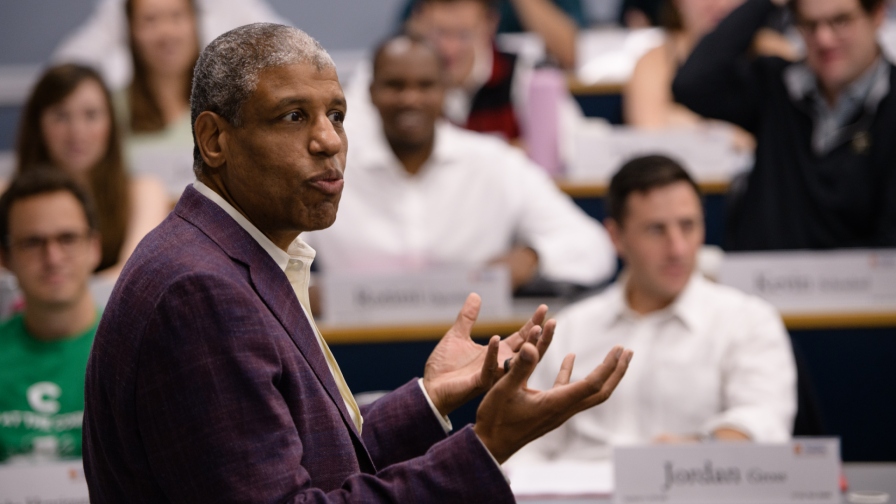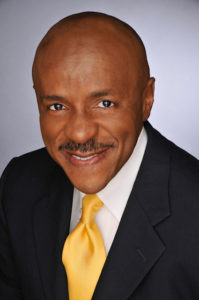
Darden Executive Education Program Offers ‘Profound’ Experiences for Diverse Communications Leaders
By Dave Hendrick
For nearly two decades, a unique executive education program has played a significant role in promoting the growth of leaders of color in the media and communications space.
The National Association for Multi-ethnicity in Communications (NAMIC) Executive Leadership Development Program (ELDP) has been hosted at the University of Virginia Darden School of Business since 2012. Darden recently welcomed its 8th cohort to the seven-month Darden Executive Education program, bringing the number of leaders who have participated from companies such as Charter Communications, Comcast, Viacom, Warner Media, ESPN and others to more than 600.
ELDP’s aims are high. In addition to propelling personal success, the program was conceived to help address longstanding industry challenges, including increasing diversity in the top ranks of leading industry companies and retaining executives of color. The program is explicitly a business development course, however. The curriculum, led by Professor Martin Davidson and taught by Darden faculty along with guest lecturers, includes courses on strategy, negotiation, and enterprise thinking, among other fundamental business topics.
The result is often nothing short of transformative, according to James Jones, former senior vice president for education and diversity solutions, who was instrumental in bringing ELDP to Darden. Jones, who is now an executive coach and diversity and inclusion consultant, recently spoke about the creation and enduring legacy of the ELDP.

James Jones
What are the origins of the NAMIC ELDP?
The program actually started in about 2000. That first ELDP class grew out of research conducted by NAMIC that concluded that there was an insufficient industry pipeline of executives of color.
The feedback at the time was that the industry didn’t have a substantial number of execs of color prepared to take on the more senior decision-making and influential roles. I’m over-simplifying, but the response by NAMIC was that we should be growing our own. There were talented professionals of color who were primed for that next little bit of finishing school, as it were, to be fully ready for those C-suite level roles. So NAMIC created the Executive Leadership Development Program.
How did the program find its way to Darden after an initial run at UCLA’s Anderson School?
The program had been very successful at Anderson, but the conversation around diversity and executive education had evolved and, frankly, the industry had shifted as well. NAMIC wanted to see where the latest thinking was, so an RFP was launched and Darden’s proposal outdistanced all the competition. I could see why as soon as I visited the School and met with Martin and a couple of other folks. I knew this was the place we needed to be. Of course, mine wasn’t the deciding vote, but I was very pleased when the NAMIC board selected Darden.
More than 600 people have come through the program. How do you quantify or describe that kind of impact?
NAMIC engaged an outside consultant to conduct a third-party study a couple of years ago to gauge the impact of the program on codifiable things like compensation, promotion and retention. The findings demonstrated that there was no question of the positive impact of participating in ELDP related to these and other factors compared to their peers with similar professional profiles who had not attended ELDP.
NAMIC also continues to receive strong endorsement from the industry it serves.
Even during times of incredible shifts within the industry, companies consistently step forward to nominate their execs of color for ELDP. These execs need to be in that room, in those conversations, in order to step back into to their roles on Monday morning and engage in the next levels of innovation and decision-making, and NAMIC doesn’t take that for granted.
There is a recurring conversation about how and why corporate diversity initiatives often do not succeed. Why do we have such a hard time getting diversity right?
This is my own thinking around this, but I believe it is because of the historical context. In the West, and in America particularly, frank conversations around race have been a third rail.
People immediately go on the defensive with the mention of the word diversity. So is there language that can be used to get people engaged in these very complex conversations without setting up that defense? Or are there ways of talking them down from this defensive posture? Of course there are, but we recognize that it’s a challenge. Many of us, because of the historic backdrop to the conversation, still think of diversity as being a code word for the history of black and white relations within this country as opposed to not only ethnic dimensions of diversity but also the other cultural dimension of diversity. We’ve moved so far beyond that old thinking. I don’t enter a room as just a black man, I enter with all my other identities as well.
So the thing we are so intentional around in ELDP is making sure that we are creating a space where all of that holistic identity conversation can take place, while at the same time driving toward the business objectives.
Is the communications and media area particularly ripe for diverse leadership?
One obvious aspect is you’re talking about entertainment and imagery. The industry is being judged every day by consumers about the stories being told and the faces that are on that screen.
And you get instant feedback: If you’re not telling my story, I’m not going to buy your content, whatever it is. So it behooves the media and entertainment industry to be out in front of this, because these incredible stories won’t be told unless those who are behind the scenes making decisions about what are the valuable and viable stories come from a variety of cultural perspectives. So, it’s a business imperative and a strategic imperative for those influence corridors to reflect that amazing diversity.
How do Darden professors lead executives through the material in the ELDP and on the topic of diversity?
Well, one quick answer is that the word “diversity” is almost never used. It’s far more than that. A faculty member reflects, “I’m teaching strategy or whatever it may be, and here in front of me is this group of incredibly diverse individuals, diverse in ways that I can and cannot see, and by virtue of their conversations, this incredible learning occurs and has at its core: identity.” That’s what’s so magical about the Darden ELDP experience.
The University of Virginia Darden School of Business prepares responsible global leaders through unparalleled transformational learning experiences. Darden’s graduate degree programs (MBA, MSBA and Ph.D.) and Executive Education & Lifelong Learning programs offered by the Darden School Foundation set the stage for a lifetime of career advancement and impact. Darden’s top-ranked faculty, renowned for teaching excellence, inspires and shapes modern business leadership worldwide through research, thought leadership and business publishing. Darden has Grounds in Charlottesville, Virginia, and the Washington, D.C., area and a global community that includes 18,000 alumni in 90 countries. Darden was established in 1955 at the University of Virginia, a top public university founded by Thomas Jefferson in 1819 in Charlottesville, Virginia.
Press Contact
Molly Mitchell
Senior Associate Director, Editorial and Media Relations
Darden School of Business
University of Virginia
MitchellM@darden.virginia.edu







